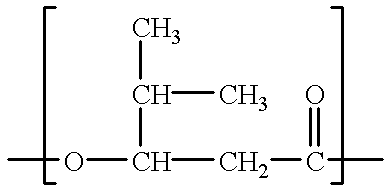Films comprising biodegradable PHA copolymers
- Summary
- Abstract
- Description
- Claims
- Application Information
AI Technical Summary
Benefits of technology
Problems solved by technology
Method used
Image
Examples
example 2
Poly(3-hydroxyvalerate-co-3-hydroxy4-methylvalerate)
Poly(3-hydroxyvalerate-co-3-hydroxy4-methylvalerate) is prepared by following the same procedure as in Example 1, with the exception that [S]-3-ethylpropiolactone (9.50 g, 94.9 mmol) and [S]-3-isopropylpropiolactone (0.71 g, 5.0 mmol) are used as the monomer charge.
example 3
Poly(3-hydroxybutyrate-co-3-hydroxyvalerate-co-3-hydroxy4-methylvalerate)
Poly(3-hydroxybutyrate-co-3-hydroxyvalerate-co-3-hydroxy4-methylvalerate) is prepared by following the same procedure as in Example 1, with the exception that [S]-3-methylpropiolactone (7.20 g, 83.6 mmol), [S]-3-ethylpropiolactone (1.14 g, 11.4 mmol), and [S]-3-isopropylpropiolactone (0.71 g, 5.0 mmol) are used as the monomer charge.
example 4
Poly(3-hydroxybutyrate-co-3-hydroxy-4-methylvalerate-co-3-hydroxyoctanoate)
Poly(3-hydroxybutyrate-co-3-hydroxy-4-methylvalerate-co-3-hydroxyoctanoate) is prepared by following the same procedure as in Example 1, with the exception that [S]-3-methylpropiolactone (9.50 g, 110 mmol), [S]-3-isopropylpropiolactone (0.41 g, 2.9 mmol), and [S]-3-pentylpropiolactone (0.50 g, 2.9 mmol) are used as the monomer charge.
PUM
| Property | Measurement | Unit |
|---|---|---|
| Fraction | aaaaa | aaaaa |
| Biodegradability | aaaaa | aaaaa |
Abstract
Description
Claims
Application Information
 Login to View More
Login to View More - R&D
- Intellectual Property
- Life Sciences
- Materials
- Tech Scout
- Unparalleled Data Quality
- Higher Quality Content
- 60% Fewer Hallucinations
Browse by: Latest US Patents, China's latest patents, Technical Efficacy Thesaurus, Application Domain, Technology Topic, Popular Technical Reports.
© 2025 PatSnap. All rights reserved.Legal|Privacy policy|Modern Slavery Act Transparency Statement|Sitemap|About US| Contact US: help@patsnap.com



